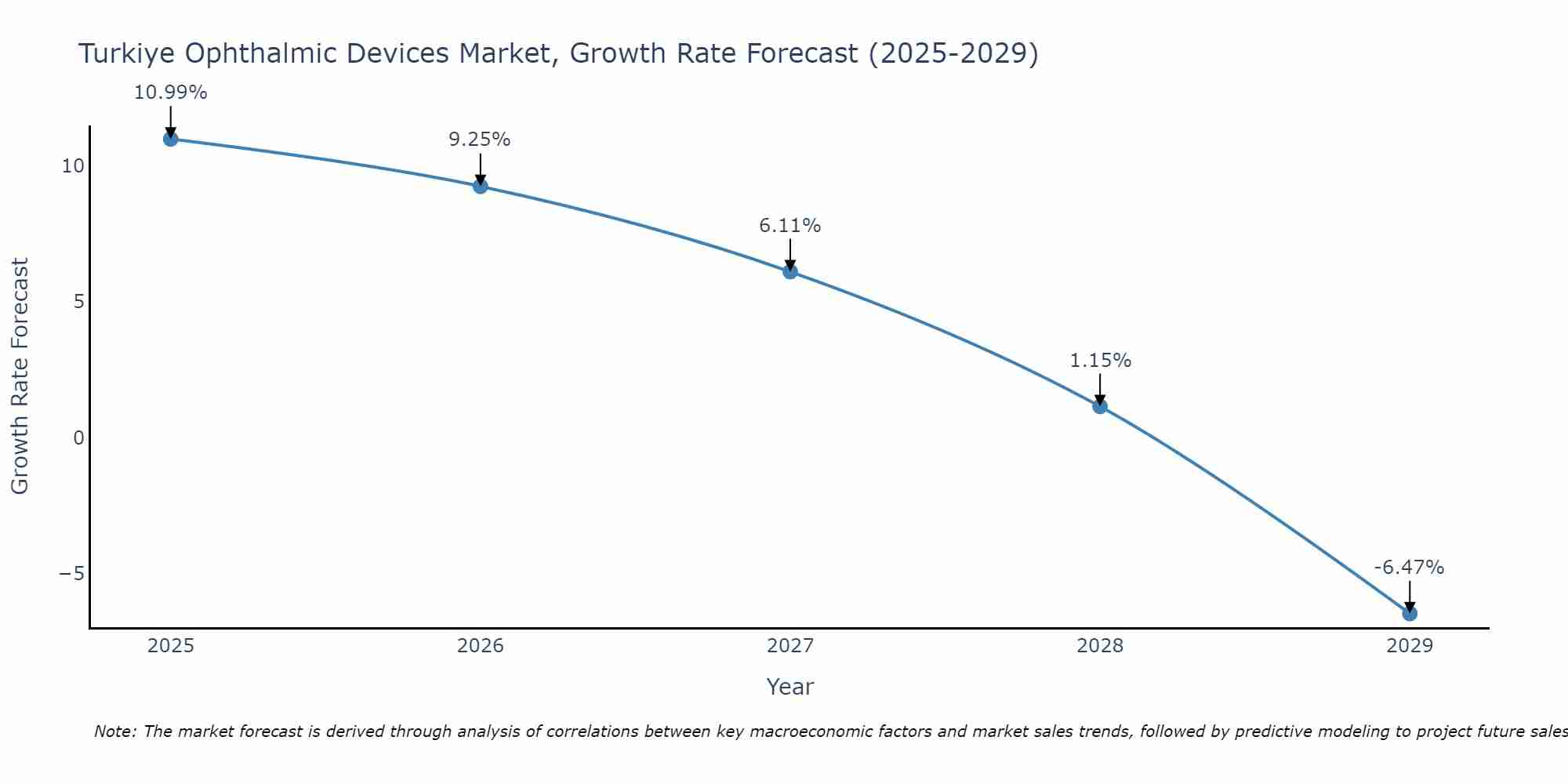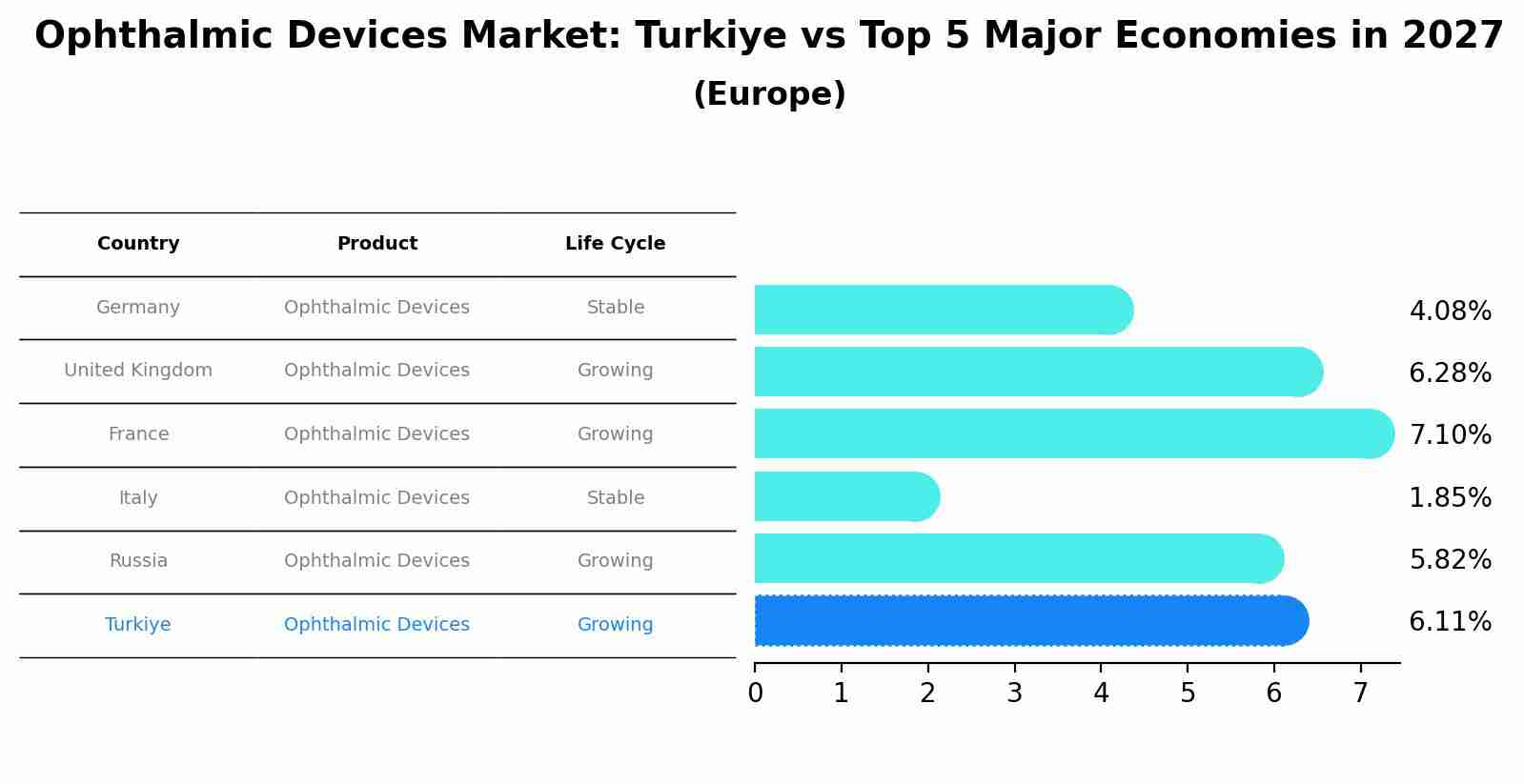Turkey Ophthalmic Devices Market Outlook | Forecast, Value, Companies, Share, COVID-19 IMPACT, Industry, Size, Trends, Revenue, Growth & Analysis
| Product Code: ETC367898 | Publication Date: Aug 2022 | Updated Date: Jul 2025 | Product Type: Market Research Report | |
| Publisher: 6Wresearch | Author: Shubham Padhi | No. of Pages: 75 | No. of Figures: 35 | No. of Tables: 20 |
Turkiye Ophthalmic Devices Market Size Growth Rate
The Turkiye Ophthalmic Devices Market may undergo a gradual slowdown in growth rates between 2025 and 2029. Beginning strongly at 10.99% in 2025, growth softens to -6.47% in 2029.

Ophthalmic Devices Market: Turkiye vs Top 5 Major Economies in 2027 (Europe)
Turkiye's Ophthalmic Devices market is anticipated to experience a growing growth rate of 6.11% by 2027, reflecting trends observed in the largest economy Germany, followed by United Kingdom, France, Italy and Russia.

Turkey Ophthalmic Devices Market Synopsis
The Turkey Ophthalmic Devices Market is a rapidly growing sector driven by an aging population, increasing prevalence of eye disorders, and technological advancements in the field of ophthalmology. Key segments, such as diagnostic devices, surgical devices, and vision care products, are witnessing significant growth due to rising demand for better eye care services. The market is characterized by the presence of both domestic and international players, offering a range of products catering to various ophthalmic conditions. Factors such as increasing healthcare expenditure, expanding healthcare infrastructure, and growing awareness about eye health are further fueling the market`s expansion. Continuous innovation and product development efforts by manufacturers are expected to drive market growth in the coming years, making Turkey an attractive destination for ophthalmic device companies.
Turkey Ophthalmic Devices Market Trends
The Turkey Ophthalmic Devices Market is witnessing several key trends, including a growing demand for advanced diagnostic tools such as optical coherence tomography (OCT) systems and fundus cameras to improve early detection and treatment of eye diseases. There is also a rising preference for minimally invasive surgical procedures, leading to increased adoption of technologies like femtosecond lasers and phacoemulsification systems. Additionally, the market is experiencing a shift towards innovative contact lens materials and designs to address the increasing prevalence of vision correction needs. Furthermore, an emphasis on telemedicine and remote monitoring solutions is gaining traction, especially in the wake of the COVID-19 pandemic, to enhance access to ophthalmic care services. Overall, these trends are shaping the Turkey Ophthalmic Devices Market towards greater efficiency, precision, and patient convenience.
Turkey Ophthalmic Devices Market Challenges
In the Turkey Ophthalmic Devices Market, several challenges are prevalent. These include increasing competition among market players leading to pricing pressures, stringent regulatory requirements for product approvals, and a lack of skilled professionals in the field of ophthalmology. Additionally, the market faces the challenge of inadequate infrastructure in certain regions, limiting access to advanced ophthalmic devices and treatments for patients. Economic uncertainties and fluctuations in currency exchange rates can also impact the market dynamics, affecting investment decisions and market growth. To overcome these challenges, companies operating in the Turkey Ophthalmic Devices Market need to focus on innovation, strategic partnerships, and market expansion strategies to stay competitive and address the evolving needs of healthcare providers and patients in the region.
Turkey Ophthalmic Devices Market Investment Opportunities
The Turkey Ophthalmic Devices Market presents promising investment opportunities due to the increasing prevalence of eye disorders and the growing elderly population. Key areas for investment include advanced diagnostic devices such as optical coherence tomography and fundus cameras, as well as surgical instruments like phacoemulsification systems and intraocular lenses. Additionally, the rising demand for laser eye surgery procedures and contact lenses offers potential for investment in innovative technologies. With a growing focus on healthcare infrastructure and advancements in ophthalmic technologies, investing in the Turkey Ophthalmic Devices Market can provide long-term growth prospects for investors looking to capitalize on the country`s expanding healthcare sector.
Jordan Agar Market Government Policies
The Turkish government regulates the ophthalmic devices market through the Turkish Medicines and Medical Devices Agency (TITCK). The agency oversees the registration, importation, distribution, and marketing of ophthalmic devices, ensuring compliance with safety and quality standards. Market authorization requires conformity assessment with relevant EU directives or Turkish standards, and manufacturers must obtain a CE mark or TITCK registration. Price controls are in place for certain medical devices, including ophthalmic products, to ensure affordability and accessibility. Additionally, the government encourages innovation and investment in the healthcare sector through incentives and support programs for research and development activities related to ophthalmic devices. Overall, the regulatory framework aims to safeguard public health, promote market competitiveness, and enhance the quality of ophthalmic healthcare services in Turkey.
Turkey Ophthalmic Devices Market Future Outlook
The Turkey Ophthalmic Devices Market is expected to witness steady growth in the coming years due to factors such as an aging population, increasing prevalence of eye disorders, and advancements in technology. The demand for ophthalmic devices, including diagnostic and surgical tools, is likely to rise as the healthcare infrastructure in Turkey improves and awareness about eye health increases. Additionally, the growing adoption of minimally invasive procedures and the development of innovative products will further drive market growth. However, regulatory challenges and pricing pressures may present some obstacles. Overall, the Turkey Ophthalmic Devices Market is poised for expansion, with opportunities for market players to capitalize on the growing need for advanced eye care solutions in the country.
Key Highlights of the Report:
- Turkey Ophthalmic Devices Market Outlook
- Market Size of Turkey Ophthalmic Devices Market, 2021
- Forecast of Turkey Ophthalmic Devices Market, 2031
- Historical Data and Forecast of Turkey Ophthalmic Devices Revenues & Volume for the Period 2018 - 2031
- Turkey Ophthalmic Devices Market Trend Evolution
- Turkey Ophthalmic Devices Market Drivers and Challenges
- Turkey Ophthalmic Devices Price Trends
- Turkey Ophthalmic Devices Porter's Five Forces
- Turkey Ophthalmic Devices Industry Life Cycle
- Historical Data and Forecast of Turkey Ophthalmic Devices Market Revenues & Volume By Product for the Period 2018 - 2031
- Historical Data and Forecast of Turkey Ophthalmic Devices Market Revenues & Volume By Optical Coherence Tomography Scanners for the Period 2018 - 2031
- Historical Data and Forecast of Turkey Ophthalmic Devices Market Revenues & Volume By Fundus Cameras for the Period 2018 - 2031
- Historical Data and Forecast of Turkey Ophthalmic Devices Market Revenues & Volume By Perimeters/Visual Field Analyzers for the Period 2018 - 2031
- Historical Data and Forecast of Turkey Ophthalmic Devices Market Revenues & Volume By Autorefractors and Keratometers for the Period 2018 - 2031
- Historical Data and Forecast of Turkey Ophthalmic Devices Market Revenues & Volume By Ophthalmic Ultrasound Imaging Systems for the Period 2018 - 2031
- Historical Data and Forecast of Turkey Ophthalmic Devices Market Revenues & Volume By Ophthalmic Pachymeters for the Period 2018 - 2031
- Historical Data and Forecast of Turkey Ophthalmic Devices Market Revenues & Volume By Tonometers for the Period 2018 - 2031
- Historical Data and Forecast of Turkey Optical Coherence Tomography Scanners Ophthalmic Devices Market Revenues & Volume By Slit Lamps for the Period 2018 - 2031
- Historical Data and Forecast of Turkey Ophthalmic Devices Market Revenues & Volume By Application for the Period 2018 - 2031
- Historical Data and Forecast of Turkey Ophthalmic Devices Market Revenues & Volume By Cataract for the Period 2018 - 2031
- Historical Data and Forecast of Turkey Ophthalmic Devices Market Revenues & Volume By Vitreo retinal disorders for the Period 2018 - 2031
- Historical Data and Forecast of Turkey Ophthalmic Devices Market Revenues & Volume By Glaucoma for the Period 2018 - 2031
- Historical Data and Forecast of Turkey Ophthalmic Devices Market Revenues & Volume By Refractor Disorders for the Period 2018 - 2031
- Historical Data and Forecast of Turkey Ophthalmic Devices Market Revenues & Volume By End-use for the Period 2018 - 2031
- Historical Data and Forecast of Turkey Ophthalmic Devices Market Revenues & Volume By Hospitals and Eye Clinics for the Period 2018 - 2031
- Historical Data and Forecast of Turkey Ophthalmic Devices Market Revenues & Volume By Academic and Research Laboratory for the Period 2018 - 2031
- Historical Data and Forecast of Turkey Ophthalmic Devices Market Revenues & Volume By Others for the Period 2018 - 2031
- Turkey Ophthalmic Devices Import Export Trade Statistics
- Market Opportunity Assessment By Product
- Market Opportunity Assessment By Application
- Market Opportunity Assessment By End-use
- Turkey Ophthalmic Devices Top Companies Market Share
- Turkey Ophthalmic Devices Competitive Benchmarking By Technical and Operational Parameters
- Turkey Ophthalmic Devices Company Profiles
- Turkey Ophthalmic Devices Key Strategic Recommendations
Frequently Asked Questions About the Market Study (FAQs):
- Single User License$ 1,995
- Department License$ 2,400
- Site License$ 3,120
- Global License$ 3,795
Search
Related Reports
- ASEAN Bearings Market (2025-2031) | Strategy, Consumer Insights, Analysis, Investment Trends, Opportunities, Growth, Size, Share, Industry, Revenue, Segments, Value, Segmentation, Supply, Forecast, Restraints, Outlook, Competition, Drivers, Trends, Demand, Pricing Analysis, Competitive, Strategic Insights, Companies, Challenges
- Europe Flooring Market (2025-2031) | Outlook, Share, Industry, Trends, Forecast, Companies, Revenue, Size, Analysis, Growth & Value
- Saudi Arabia Manlift Market (2025-2031) | Outlook, Size, Growth, Trends, Companies, Industry, Revenue, Value, Share, Forecast & Analysis
- Uganda Excavator, Crane, and Wheel Loaders Market (2025-2031) | Strategy, Consumer Insights, Analysis, Investment Trends, Opportunities, Growth, Size, Share, Industry, Revenue, Segments, Value, Segmentation, Supply, Forecast, Restraints, Outlook, Competition, Drivers, Trends, Demand, Pricing Analysis, Competitive, Strategic Insights, Companies, Challenges
- Rwanda Excavator, Crane, and Wheel Loaders Market (2025-2031) | Strategy, Consumer Insights, Analysis, Investment Trends, Opportunities, Growth, Size, Share, Industry, Revenue, Segments, Value, Segmentation, Supply, Forecast, Restraints, Outlook, Competition, Drivers, Trends, Demand, Pricing Analysis, Competitive, Strategic Insights, Companies, Challenges
- Kenya Excavator, Crane, and Wheel Loaders Market (2025-2031) | Strategy, Consumer Insights, Analysis, Investment Trends, Opportunities, Growth, Size, Share, Industry, Revenue, Segments, Value, Segmentation, Supply, Forecast, Restraints, Outlook, Competition, Drivers, Trends, Demand, Pricing Analysis, Competitive, Strategic Insights, Companies, Challenges
- Angola Excavator, Crane, and Wheel Loaders Market (2025-2031) | Strategy, Consumer Insights, Analysis, Investment Trends, Opportunities, Growth, Size, Share, Industry, Revenue, Segments, Value, Segmentation, Supply, Forecast, Restraints, Outlook, Competition, Drivers, Trends, Demand, Pricing Analysis, Competitive, Strategic Insights, Companies, Challenges
- Israel Intelligent Transport System Market (2025-2031) | Strategy, Consumer Insights, Analysis, Investment Trends, Opportunities, Growth, Size, Share, Industry, Revenue, Segments, Value, Segmentation, Supply, Forecast, Restraints, Outlook, Competition, Drivers, Trends, Demand, Pricing Analysis, Competitive, Strategic Insights, Companies, Challenges
- Uganda Precast and Aggregate Market (2025-2031) | Strategy, Consumer Insights, Analysis, Investment Trends, Opportunities, Growth, Size, Share, Industry, Revenue, Segments, Value, Segmentation, Supply, Forecast, Restraints, Outlook, Competition, Drivers, Trends, Demand, Pricing Analysis, Competitive, Strategic Insights, Companies, Challenges
- Australia IT Asset Disposal Market (2025-2031) | Strategy, Consumer Insights, Analysis, Investment Trends, Opportunities, Growth, Size, Share, Industry, Revenue, Segments, Value, Segmentation, Supply, Forecast, Restraints, Outlook, Competition, Drivers, Trends, Demand, Pricing Analysis, Competitive, Strategic Insights, Companies, Challenges
Industry Events and Analyst Meet
Our Clients
Whitepaper
- Middle East & Africa Commercial Security Market Click here to view more.
- Middle East & Africa Fire Safety Systems & Equipment Market Click here to view more.
- GCC Drone Market Click here to view more.
- Middle East Lighting Fixture Market Click here to view more.
- GCC Physical & Perimeter Security Market Click here to view more.
6WResearch In News
- Doha a strategic location for EV manufacturing hub: IPA Qatar
- Demand for luxury TVs surging in the GCC, says Samsung
- Empowering Growth: The Thriving Journey of Bangladesh’s Cable Industry
- Demand for luxury TVs surging in the GCC, says Samsung
- Video call with a traditional healer? Once unthinkable, it’s now common in South Africa
- Intelligent Buildings To Smooth GCC’s Path To Net Zero













